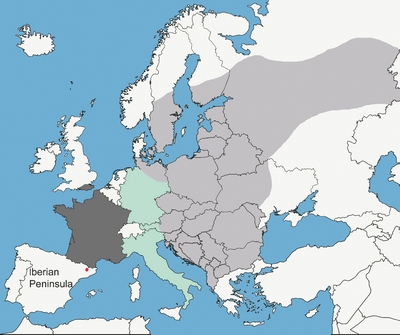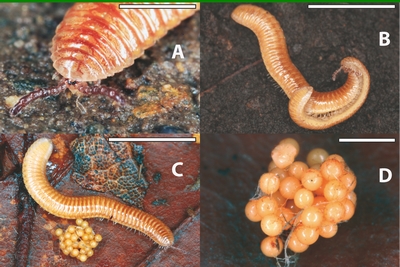Notas / Notes
First record of the Family Polyzoniidae Newport, 1844 (Diplopoda, Polyzoniida) in the Iberian Peninsula
Eduardo Mateos
Departament de Biologia Evolutiva, Ecologia i Ciències Ambientals; Facultat de Biologia; Universitat de Barcelona, Avinguda Diagonal 643, 08028 Barcelona, Spain
Email: emateos@ub.edu —
ORCID iD: https://orcid.org/0000-0001-9741-5744
| |
ABSTRACT
Millipedes (Diplopoda) are a group of terrestrial arthropods with high specific diversity at a global scale. There are 12,000
species worldwide, distributed in 16 orders and 145 families. The family Polyzoniidae is represented in Europe by three species,
being Polyzonium germanicum Brandt, 1837 the one with the widest distribution. To date there are no records in the Iberian Peninsula for this family.
Polyzonium germanicum mainly inhabits humid or very humid soils, either in coniferous, deciduous or mixed forests. This note describes a population
of P. germanicum in soils of a beech forest located in the north of Barcelona province (Spain). This report represents the first record of
P. germanicum and the family Polyzoniidae in the Iberian Peninsula.
Keywords: Millipedes;
Polyzonium germanicum; Cadí Moixeró Natural Park; Gresolet forest; beech forest.
|
| |
RESUMEN
Primera cita de la Familia Polyzoniidae Newport, 1844 (Diplopoda, Polyzoniida) en la Península Ibérica
Los milpiés (Diplopoda) son un grupo de artrópodos terrestres con una alta diversidad específica a escala global. En el mundo
están citadas unas 12,000 especies distribuidas en 16 órdenes y 145 familias. La familia Polyzoniidae está representada en
Europa por tres especies, siendo Polyzonium germanicum Brandt, 1837 la que presenta una distribución más amplia. Hasta la fecha no existen citas en la Península Ibérica para esta
familia. Polyzonium germanicum habita fundamentalmente en suelos de bosques húmedos o muy húmedos, ya sean de coníferas, de frondosas o bosques mixtos.
La presente nota describe una población de P. germanicum localizada en suelos de un hayedo del norte de la provincia de Barcelona (España). Este registro representa la primera cita
de la especie P. germanicum y de la familia Polyzoniidae para la fauna ibérica.
Palabras clave: Milpiés;
Polyzonium germanicum; Parc Natural del Cadí Moixeró; bosc de Gresolet; hayedo.
|
| |
Recibido/Received: 05/05/2020; Aceptado/Accepted: 13/11/2020; Publicado en línea/Published online: 21/05/2021
Citation / Cómo citar este artículo: Mateos, E. 2021. First record of the Family Polyzoniidae Newport, 1844 (Diplopoda, Polyzoniida) in the Iberian Peninsula.
Graellsia, 77(1): e129. https://doi.org/10.3989/graellsia.2021.v77.279
Copyright: © 2021 SAM & CSIC. This is an open-access article distributed under the terms of the Creative Commons Attribution 4.0 International (CC BY 4.0) License.
|
Millipedes (Class Diplopoda) are terrestrial arthropods that belong to the subphylum Myriapoda. There are probably as many
as 80,000 millipede species worldwide (Sierwald & Bond, 2007), but around 12,000 have been described so far (Brewer et al., 2012), distributed in 16 orders and 145 families (Shelley, 2007). Of this astonishing diversity 9 orders, 48 families and well over 1,500 species are currently described from Europe (Kime & Enghoff, 2017). The family Polyzoniidae Newport, 1844, with 6 genera and 20 described species worldwide (Enghoff et al., 2015), is represented in Europe by three species of the genus Polyzonium Brandt, 1837, P. eburneum Verhoef, 1907, P. transsilvanicum Verhoeff, 1898 and P. germanicum Brandt, 1837. The first two mentioned species have a restricted distribution in central and Eastern Europe, respectively,
while P. germanicum is widespread in most of the continent (Kime & Enghoff, 2011). Two main European populations (Fig. 1), one in the eastern half of Europe and one in the western half (including France and SE Britain), have been described for P. germanicum (see Kime & Enghoff, 2011). An area of central Europe, with only a few records of the species, seems to separate these two populations (Kime, 2001), but no morphological (Schubart, 1934) nor ecological (Kime & Enghoff, 2011) differences have been found between them. To date P. germanicum was not known in the Iberian Peninsula.
|
 Fig. 1.—Polyzonium germanicum distribution map. Data from Enghoff & Kime (2009) and Kime & Enghoff (2011). Dark gray: western population; light gray: eastern population; green: area located between eastern and western populations
with few records for the species; white: no records for the species; red dot: forest population of Gresolet (Spain) described
in the present report.
Fig. 1.—Polyzonium germanicum distribution map. Data from Enghoff & Kime (2009) and Kime & Enghoff (2011). Dark gray: western population; light gray: eastern population; green: area located between eastern and western populations
with few records for the species; white: no records for the species; red dot: forest population of Gresolet (Spain) described
in the present report.
Fig. 1.—Mapa de distribución de Polyzonium germanicum. Datos de Enghoff & Kime (2009) y Kime & Enghoff (2011). Gris oscuro: población occidental; gris claro: población oriental; verde: área ubicada entre las poblaciones oriental y
occidental, con pocos registros de la especie; blanco: sin registros para la especie; punto rojo: población forestal de Gresolet
(España) descrita en el presente informe.
|
|
This report describes a population that has been found in the Gresolet forest (Fig. 1), located into the Cadí-Moixeró Natural Parc (Saldes municipality, Barcelona province, Spain). Ten specimens of P. germanicum were collected by the author (with collection permit inside the natural park) in two dates (14.xi.2008, 5 young specimens,
and 14.v.2009, 2 ♀♀ and 3 ♂♂) from litter layer and under logs and stones in the beech forest at 1,300 m above sea level (position
42°15’32.5” N, 1°42’47.2” E). The five young specimens are preserved in absolute ethanol and deposited at the E. Mateos collection
(Departament de Biologia Evolutiva, Ecologia i Ciències Ambientals, Facultat de Biologia, Universitat de Barcelona). The five
adult specimens (2 ♀♀ and 3 ♂♂) are preserved in 70% ethanol and deposited at the Centre de Recursos de Biodiversitat Animal
(Facultat de Biologia, Universitat de Barcelona) with collection codes CRBA-92751 to CRBA-92755. The Gresolet beech forest
represents the southernmost locality of the western European population of the species and the first record for the Iberian
Peninsula. The forest is crossed by the Mulleres stream and is distributed in a range of altitudes between 1,000 and 2,000
m. The area is characterized by a continental climate with Mediterranean influence, with relatively high precipitation and
soft temperatures. The Gresolet forest host a mosaic of plant communities including oak grove (Quercus pubescens Willd.), beech forest (of Fagus sylvatica L.), fir forest (of Abies alba Mill.) and pine forests (of Pinus sylvestris L. and Pinus mugo Turra).
Polyzonium germanicum is a distinctive rather slug-like millipede, some 5 to 18 mm in length, with a yellowish to orange brown body composed of
35–60 segments and a very small and characteristic triangular head (Fig. 2A); when curled into a spiral it is said to resemble beech bud scales (British Myriapod & Isopod Group, 2020; Enghoff et al., 2015). In P. germanicum (as in all Polyzoniida) males and females are externally very similar. Only the transformation of legs-9 and legs-10 into
gonopods in males (in stadium IV) allows differentiating the sexes (Couret & David, 1985). Polyzonium germanicum is a liquid feeder species (Couret, 1985) and very hygrophilous in its habitat requirements (David, 1983). Forests with thick humus layers and high humidity levels around the year is the preferred habitat of the species (David & Vannier, 1995). These forests may be coniferous, mixed or deciduous, with dense, open or clearing structure, but always with wet (or even
waterlogged) soils (see Kime & Enghoff, 2011). Characteristically P. germanicum females brood the eggs (Enghoff, 1984). They remain curled up around them until hatching, while secreting a repellent substance that probably also acts as a biocide
preventing the rotting of the eggs (Minelli, 2015). A couple of specimens collected on 14.v.2009 were observed during mating activities (Fig. 2B), and one female deposited an egg mass on 16.vii.2009 (Figs. 2C–D).
|
 Fig. 2.—Polyzonium germanicum. A. Head and first trunk segments, scale bar = 1 mm. B. Male (right specimen) and female (left specimen) pairing for sperm
transfer, scale bar = 5 mm. C. Female and eggs, scale bar = 5 mm. D. Eggs, scale bar = 1 mm.
Fig. 2.—Polyzonium germanicum. A. Head and first trunk segments, scale bar = 1 mm. B. Male (right specimen) and female (left specimen) pairing for sperm
transfer, scale bar = 5 mm. C. Female and eggs, scale bar = 5 mm. D. Eggs, scale bar = 1 mm.
Fig. 2.—Polyzonium germanicum. A. Cabeza y primeros segmentos del tronco, barra de escala = 1 mm. B. Macho (espécimen de la derecha) y hembra (espécimen
de la izquierda) en apareamiento para la transferencia de esperma, barra de escala = 5 mm. C. Hembra y huevos, barra de escala
= 5 mm. D. Huevos, barra de escala = 1 mm.
|
|
AcknowledgementsTop
I would like to thank Dr. Henrik Enghoff for the identification of the specimens. José D. Gilgado and Per Djursvoll provided
valuable comments that improved the manuscript.
ReferencesTop
|
|
|
○
|
Brewer, M. S.,
Sierwald, P.
&
Bond, J. S., 2012. Millipede taxonomy after 250 years: Classification and taxonomic practices in a mega-diverse yet understudied arthropod group. PLoS ONE, 7
(5): e37240. https://doi.org/10.1371/journal.pone.0037240
|
|
○
|
British Myriapod & Isopod Group, 2020. Available from http://www.bmig.org.uk/species/polyzonium-germanicum [accessed 05 May 2020].
|
|
○
|
Couret, T., 1985. Recherches sur la biologie et l’ecologie de deux populations de Diplopodes en forêt d’Orléans: Polyzonium germanicum Brandt,
1831 et Polydesmus angustus Latzel, 1884. PhD., University of Orleans.
|
|
○
|
Couret, T.
&
David, J. F., 1985. Recherche des stades de maturité sexuelle chez le myriapode Polyzonium germanicum Brandt, 1831 (Diplopoda, Polyzoniida). Revue d’Écologie et de Biologie du Sol,
22(29): 247–258.
|
|
○
|
David, J. F., 1983.
Contribution à l’étude des populations de Diplopodes en fôret d’Orléans et de leur rôle dans la dégradation de la litière. PhD., University of Orleans.
|
|
○
|
David, J. F.
&
Vannier, G., 1995. Sesonal field analyses of water and fat content of Polyzonium germanicum (Diplopoda, Polyzonidae). Journal of Zoology, 236: 667–679. https://doi.org/10.1111/j.1469-7998.1995.tb02738.x
|
|
○
|
Enghoff, H., 1984. Phylogeny of millipedes - a cladistic analysis. Journal of Zoological Systematics and Evolutionary Research, 22
(1): 8–26. https://doi.org/10.1111/j.1439-0469.1984.tb00559.x
|
|
○
|
Enghoff, H.,
Golovatch, S.,
Short, M.,
Stoev, P.
&
Wesener, T., 2015. Diplopoda – Taxonomic overview. In:
Minelli
A.
(Ed.). Treatise on Zoology – Anatomy, Taxonomy, Biology. The Myriapoda, Vol. 2. Brill. Leiden: 363–447.
|
|
○
|
Enghoff
H.
&
Kime
R. D., 2009. Fauna Europaea: Diplopoda. Fauna Europaea version 2.0. Available from http://www.faunaeur.org [accessed 05 May 2020].
|
|
○
|
Kime, R. D., 2001. The continental distribution of British and Irish millipedes, part 2. Bulletin of the British Myriapod and Isopod Group,
17: 7–42.
|
|
○
|
Kime, R. D.
&
Enghoff, H., 2011. Atlas of European Millipedes (Class Diplopoda). Vol.1 Orders Polyxenida, Glomerida, Platydesmida, Siphonocryptida, Polyzoniida,
Callipodida, Polydsmida. Pensoft Publishers, Sofia-Moscow & European Invertebrate Survey, Leiden, 282 pp.
|
|
○
|
Kime
R. D.
&
Enghoff
H., 2017. Atlas of European millipedes 2: Order Julida (Class Diplopoda). European Journal of Taxonomy, 346: 1–299. https://doi.org/10.5852/ejt.2017.346
|
|
○
|
Minelli, A.
(Ed.).
2015. The Myriapoda, vol. 2. Brill. Leiden
& Boston. 482 pp.
|
|
○
|
Schubart, O., 1934. Diplopoda. Tierwelt Deutschlands,
28: 1–318.
|
|
○
|
Shelley, R. M., 2007. Taxonomy of extant Diplopoda (Millipeds) in the modern era: Perspectives for future advancements and observations on the global
diplopod community (Arthropoda: Diplopoda). Zootaxa, 1668: 343–362. https://doi.org/10.11646/zootaxa.1668.1.18
|
|
○
|
Sierwald, P.
&
Bond, J. E., 2007. Current status of the Myriapod Class Diplopoda (Millipedes): taxonomic diversity and phylogeny. Annual Review of Entomology, 52: 401–420. https://doi.org/10.1146/annurev.ento.52.111805.090210
|